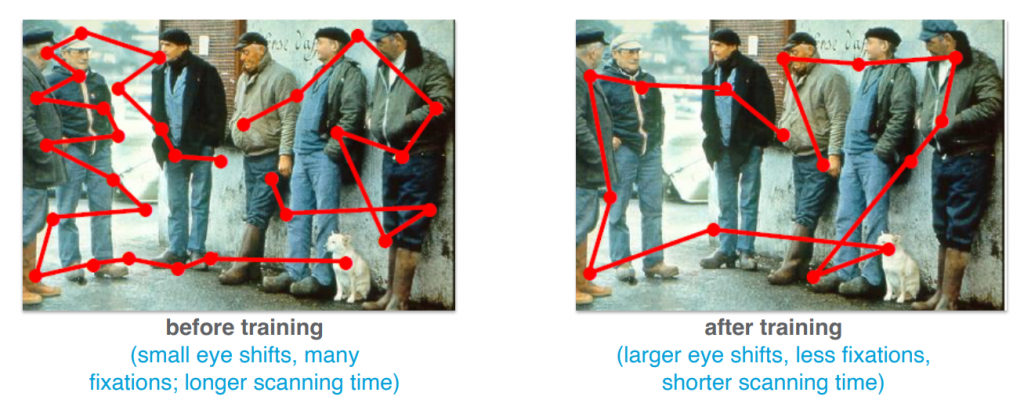The PC-based treatment approach was originally developed by Prof. Zihl (1988, 1990) and was used with various modifications in 13 studies on a total of 551 patients with homonymous visual field loss and persistent visual disabilities.
The main outcome of saccadic training is a significant improvement in visual search performance accompanied by more efficient oculomotor strategies, and a reduction in visual disability as assessed by standardized questionnaires and behavioral measures. These include measures of improvements in navigation skills and object finding. The efficacy of this treatment approach to improving of visual overview and visual exploration is superior to practice with reading (Schuett et al., 2012), non-specific visual training (Roth et al., 2009), standard occupational therapy (Mödden et al., 2012) or counseling with regards to coping strategies (Zihl, 2011). Importantly, time since brain injury (Zihl, 2011) and age of hemianopic patients (Schuett & Zihl, 2012) do not play a significant role in the treatment effect.
Use of visual search in improving search efficiency of hemianopic patients was first reported in 1988. Other than its use in various forms in a limited number of rehabilitation clinics over the last few decades, there has been a marked lack of an evidence-based vision specific medical device broadly accessible to patients despite there being a large body of evidence, including randomized control trials that have shown that patients benefit from systematic eye movement training.
NeuroEyeCoach was developed to address this need and was based upon this body of evidence to provide a standardised protocol for clinical management of patients using a compensatory technique. NeuroEyeCoach utilizes the Visual Search Task psychological paradigm. During a training session the patient is asked to search a computer screen and decide if a particular item is present amongst distractor items. The level of difficulty is systematically altered by changing the target positions, the number of distractors, and similarity between the search for the target and distractors. NeuroEyeCoach is self-adaptive and adjusts the task difficulty to the patient’s deficits while encouraging eye movement efficiency. The program has 12 levels of increasing difficulty that can be completed in a minimum of 36 sessions, each taking around 15-20 minutes. The pre- and post-therapy evaluation options within the program enable the clinicians and patients to quantify the effect of therapy. The program can be completed in 2-3 weeks if performed daily, and has been designed such that a patient can complete the therapy at home on an outpatient basis if required.
Significant improvement in visual search performance and more efficient oculomotor strategies
 NeuroEyeCoach was most recently validated in a 300 patients peer-reviewed clinical study published in Reed Elsevier’s Cortex, which demonstrated significant improvements in visual search. This study is largest ever published eye movement training study. Clinical results point to strong efficacy of NeuroEyeCoach, with 87% improvements in search time and 80% of patients making fewer errors.
NeuroEyeCoach was most recently validated in a 300 patients peer-reviewed clinical study published in Reed Elsevier’s Cortex, which demonstrated significant improvements in visual search. This study is largest ever published eye movement training study. Clinical results point to strong efficacy of NeuroEyeCoach, with 87% improvements in search time and 80% of patients making fewer errors.
Results were shown not dependent on age, gender, side of blindness, age at onset of brain injury nor the time elapsed since the brain injury.
The significance is that NeuroEyeCoach allows patients to see things they would have otherwise missed, not only are they making fewer errors but they are also seeing things much faster.
Clinical Studies on NeuroEyeCoach:
Efficacy and Predictors of Recovery of function after eye movement training in 296 hemianopic patients
Author: Sahraie, A., Jose G Romano, Matilda H. Cederblad, Sigrid Kenkel.
Publication: Cortex 125 (2020) 149-160
http://novavision.com/wp-content/uploads/2023/03/Cortex-study-Feb-2020.pdf
Use of NeuroEyeCoach to improve eye movement efficacy in patients with homonymous visual field loss
Author: Sahraie, A., Smania, N., Zihl, J.
Publication: BioMed Research International
http://novavision.com/wp-content/uploads/2023/03/BioMed-Study.pdf

